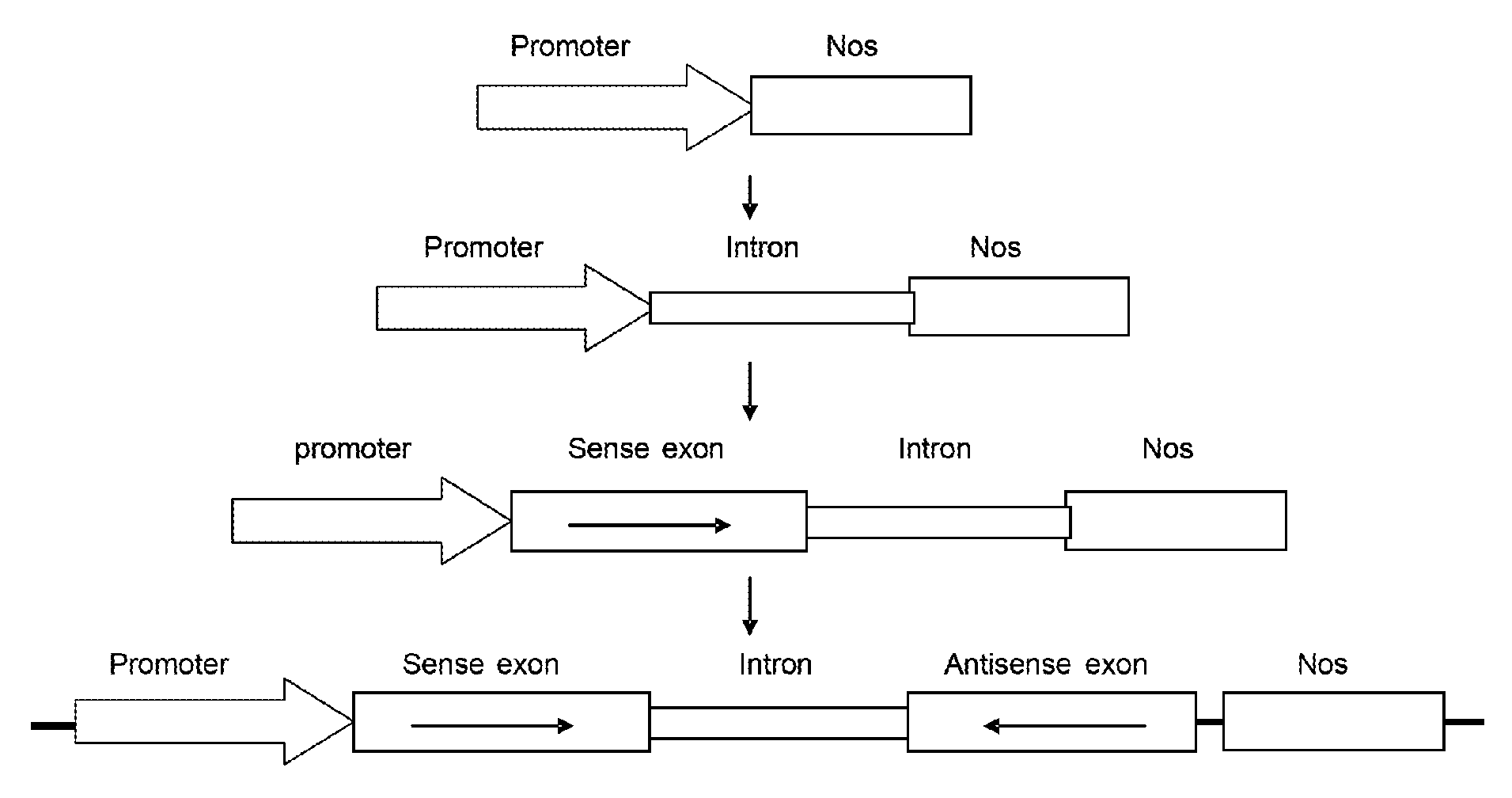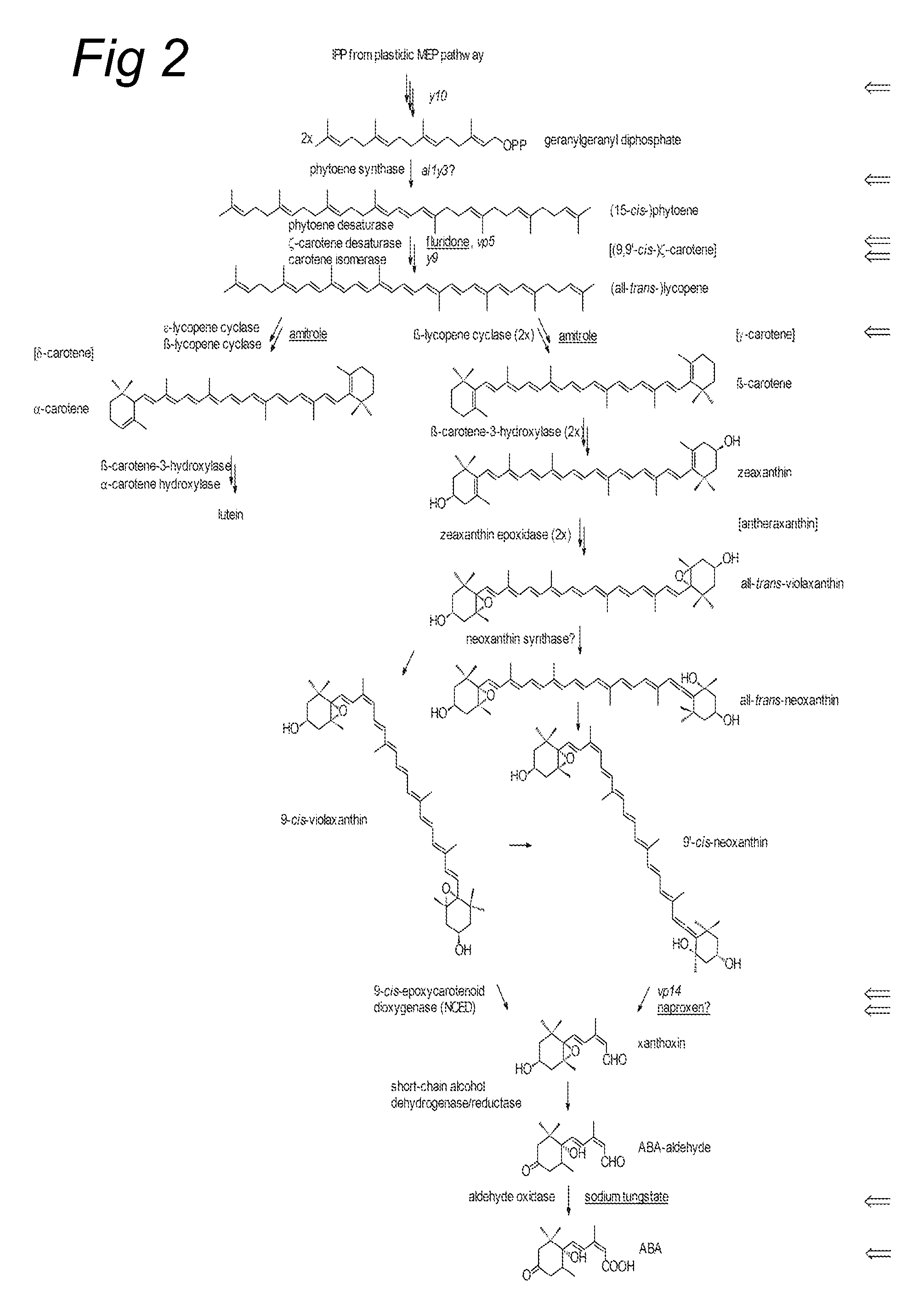Resistance against parasitic weeds
a technology of resistance and parasitic weeds, applied in the field of plant biotechnology and plant breeding, can solve the problems of large agricultural yield loss, low specificity, and heavy damage to infected crops
- Summary
- Abstract
- Description
- Claims
- Application Information
AI Technical Summary
Benefits of technology
Problems solved by technology
Method used
Image
Examples
example 1
General Material and Methods
1.1 Plant Material and Chemicals
[0132]Maize inbred W22 was obtained from Vicky Child, IACR, UK and inbred line Dent was obtained from J C Robinson Seeds, The Netherlands. Maize seeds deficient in chlorophyll and carotenoid biosynthesis were obtained from the Maize Genetics COOP Stock Center, Urbana, Ill. (mutants lw1, y10, vp5, vp14, y9, all-y3, cl1 311AA). Cowpea (Vigna unguiculata (L.) Walp) seeds were obtained from Seriba Katilé, Institut d'Economie Rurale, Mali. Sorghum bicolor, variety CSH-1 was obtained from Bob Vasey, Sheffield University, UK. Striga (Striga hermonthica (Del.) Benth) seeds were collected from a maize field in 1994, Kibos, Kenya and Striga hermonthica seeds used in germination bioassay with sorghum root exudates were collected from a sorghum field in Sudan in 1995 and were obtained from Bob Vasey. Orobanche crenata seeds were obtained from D. M. Joel, Newe-Ya'ar Research Center, Israel.
[0133]The following inhibitors of isoprenoid pa...
example 2
Elucidation of Strigolactone Formation in Maize and Cowpea
2.1 The Use of Inhibitors Early in the Pathway
[0136]W22 seedlings were grown in perlite in separate tubes for 3 days at 25° C. Tubes were covered with aluminum foil and the plants were watered with tap water. Then solutions of inhibitors were applied and seedlings were grown in the presence of inhibitors for an additional 5 days. 10 μM mevastatin and 100 μM fosmidomycin were used to inhibit isoprenoid formation in the cytosol and plastids, respectively and 25 μM fluridone was used to block carotenoid formation. After 5 days, seedlings were taken from the perlite and any perlite clinging to the roots was carefully removed. Plants were put into tap water in glass tubes for 6 hrs at 25° C. A dilution of 70 mg root fresh weight / mL root exudate was used for the bioassay. Root exudates from 10 individual plants for each treatment were tested. For amitrole experiments, germinated seeds of maize inbred line DENT were sown in perlite...
example 3
Use of Inhibitors to Decrease Parasitic Weed Infestation
[0155]In the above examples, inhibitors of carotenoid biosynthesis were used to proof the biosynthetic origin of the germination stimulants. In this example, we describe the use of these inhibitors to reduce the formation of germination stimulants in situ, in planta and the consequences this has for parasitic weed infestation. Hereto, rice seeds (Taichung Native 1, Tn 1) were surface sterilized with 70% ethanol for 1 minute, and then washed immediately with demi water. Subsequently, 2% sodium hypochlorite plus 0.02% Tween20 were added. After 30 minutes the seeds were washed 5 times during 10 minutes in sterile demi water. The seeds were sown in a 9 cm petridish with filter paper wetted with 4 ml sterile demi water and incubated at 28° C. for two days. Then the seeds were placed in washed silver sand in pots (24 cm high×10 cm diameter). Two seeds were sown in each pot and seedlings were thinned to one per pot 7 days after sowing...
PUM
| Property | Measurement | Unit |
|---|---|---|
| Tm | aaaaa | aaaaa |
| temperature | aaaaa | aaaaa |
| pH | aaaaa | aaaaa |
Abstract
Description
Claims
Application Information
 Login to View More
Login to View More - R&D
- Intellectual Property
- Life Sciences
- Materials
- Tech Scout
- Unparalleled Data Quality
- Higher Quality Content
- 60% Fewer Hallucinations
Browse by: Latest US Patents, China's latest patents, Technical Efficacy Thesaurus, Application Domain, Technology Topic, Popular Technical Reports.
© 2025 PatSnap. All rights reserved.Legal|Privacy policy|Modern Slavery Act Transparency Statement|Sitemap|About US| Contact US: help@patsnap.com



